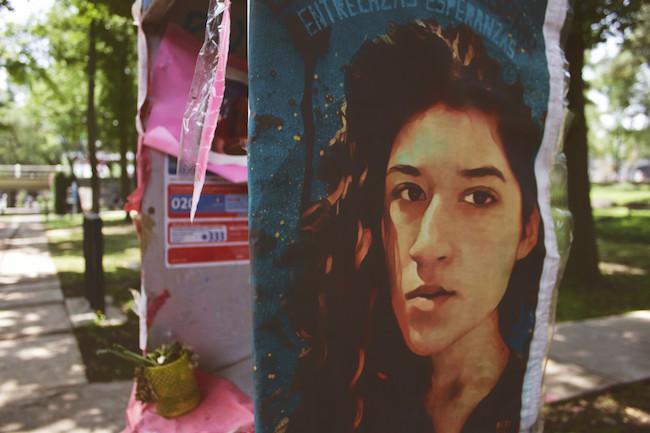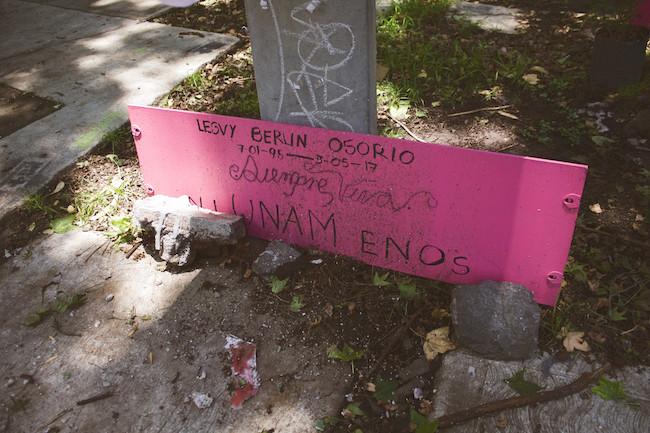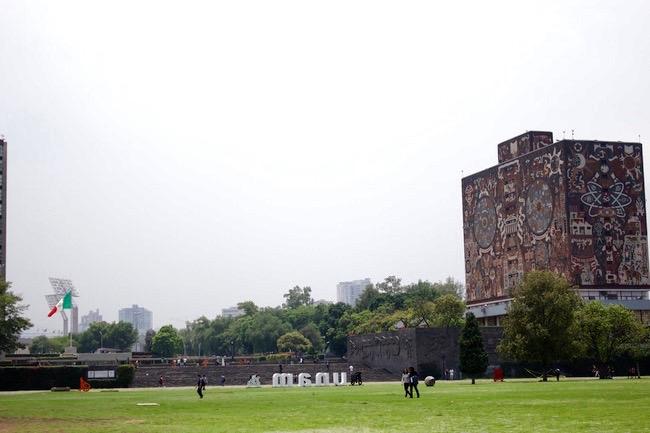
The death of 22-year-old Lesvy Berlin Rivera Osorio on May 3 at the National Autonomous University of Mexico (UNAM), Latin America’s largest public university in Mexico City, is a tale of pervasive government indifference toward violence against women in Mexico. Rivera was found dead with a telephone cord wrapped around her neck on the campus, long considered a sanctuary by students and the intellectual community of Mexico’s capital. Her death sparked outrage among students and community members. Dozens have mobilized to denounce the death not only as murder, but also as feminicide.
The investigation into Rivera’s death reflects the Mexican justice system’s failure to adequately address the issue of violence against women on a national level. Despite the enactment of federal legislation to prevent and prosecute feminicide, defined as the extreme violence against women due to their gender, marked by impunity that violates their human rights and results in death, authorities have failed to apply a gender analysis into their investigation of Rivera’s death. In fact, murders of women are on the rise in Mexico, and have been for several decades. Today, this issue is not limited to Ciudad Juarez—the northern Mexican city notorious for its violence against women. It’s a human rights crisis that has spread throughout the country. In Mexico City, once considered a safe haven exempt from the violence plaguing the rest of Mexico, women are also murdered with impunity.
This month Mexico City’s public prosecutor ruled that Rivera committed suicide and detained her boyfriend Jorge Luis González for allegedly failing to intervene. González has been charged with homicide by omission for not doing enough to prevent Rivera’s death. In this case, Mexican law cites the perpetrator’s negligence, and not intent, as is the case with crimes like homicide and feminicide. The ruling comes despite video footage released by UNAM that shows him beating Rivera just minutes before her death.
Rivera’s family and activists have rejected claims of her suicide and seek to challenge a society that tends to forget about its women victims: Only 24 % of the 3,892 feminicides identified in 2012 and 2013 were investigated by authorities and only 1.6 % led to sentencing. Official and human rights groups’ statistics vary, but reports document an increase in feminicide that dates back at least twenty-five years.
At a conference held at UNAM in June, Rivera’s mother Araceli Osorio alleged that Mexico City Attorney General’s office (PGJ) has blamed Rivera for her own death by publishing information about alleged drug use, and conducted an inadequate investigation into her death. The day after Lesvy was found, the PGJ tweeted that Lesvy used drugs and was a high school dropout and not an UNAM student. The tweets, which prompted thousands of women to respond with the “#IfTheyKillMe” hashtag to denounce the attempt to discredit Lesvy by tweeting ways in which they might also be blamed for their own murder, were later deleted.
“Authorities have violated her rights,” said Araceli at UNAM. “Since the beginning of the investigation they have stigmatized my daughter for the simple fact of being an independent young woman.”
Araceli says that the public prosecutor’s office has also put up a series of roadblocks that have made it difficult for her family to follow the case. In the first days after her alleged murder, Araceli says authorities visited the house where her daughter was living with her boyfriend and collected some of her possessions without consulting their family. They consulted González, Rivera’s boyfriend, who friends say had a history of beating and abusing her.
It also took authorities nearly two months to give Araceli and her lawyer access to the investigation records. Araceli condemned this lack of transparency. “We have been kept in the dark from the beginning. We don’t know the state in which she was found, who was there to investigate, or whether they have followed the appropriate protocols to investigate feminicide,” she said.
“It has been said that the death of Lesvy is the straw that broke the camel’s back,” said Araceli. “We know more women have been killed at UNAM, and their deaths are invisible. It is said that Lesvy’s case is emblematic, while the other cases are invisible. Within our family, we say her case is emblematic for all the wrong reasons.”
Prosecutor Rules Suicide, Dismisses Calls to Denounce Feminicide
Mexico City’s public prosecutor ruled that Rivera killed herself in front of her boyfriend after an argument. Rivera wrapped a telephone cord around her neck and choked herself as she let her body go limp, according to a PGJ press release. Araceli and her legal team dispute the ruling and suspect that Gonzales murdered Rivera based upon video footage of him beating her in the moments before her death.
Mexican authorities have a history of jumping to the conclusion that women have committed suicide before considering them victims of feminicide. The death of Mariana Lima, a woman killed by her husband and judicial police officer Julio Cesar Hernandez Ballinas in 2010 in Mexico State, is one such internationally famous case. Lima, who had suffered domestic violence at the hands of Ballinas, was found hung in her home. Ballinas told authorities and her mother Irinea Buendía that she had killed herself and state authorities eventually ruled Mariana’s death a suicide.
Buendía took the case to Mexico’s Supreme Court and, after years of advocating for justice for her daughter, the court ruled a reinvestigation of the case on charges of feminicide. Lima’s case marked a shift in the way that violent murders of women are investigated in Mexico.
Under Mexican law, violent deaths of women must be investigated with due diligence and a coordinated effort by authorities to implement a gender perspective that avoids value judgements and the re-victimization, by way of judicial irregularities and institutional violence, of women victims of feminicide and sexual violence.
At a course on feminicide in Mexico held at the Museum of Memory and Tolerance in Mexico City this month, Buendía brought up Rivera’s case, saying that despite the historic Supreme Court win, many problems continue to exist within investigations of feminicide. “Unfortunately, just like in my daughter’s case, authorities ruled Lesvy committed suicide. Authorities have no political will,” said Buendía.
“That is the first obstacle we encounter. The Mariana Lima sentence dictates that authorities must investigate with a gender lens and that all levels of government must be trained to do so. [The handling of] Lesvy’s case lacks a gender lens. If authorities don’t investigate appropriately, they’ll never be able to determine that it was feminicide,” she said.
An Interamerican Court of Human Rights (IACHR) ruling on the torture and murder of a group of women in Ciudad Juarez in 2001 precedes the Mexican Supreme Court ruling. Families of three women murdered and abandoned in a cotton field denounced authorities for irregularities in investigations that included neglecting the preservation of the crime scene and the destruction of a women’s corpse by local animals. The IACHR ruled against the Mexican government and denounced the impunity that surrounds these cases. The detention and prosecution of perpetrators and accountability of authorities that violate victim and families’ rights, all fall under the “cotton field” case.

Feminicide, In Context
Feminicide is an alarming issue that dates back more than twenty years in Mexico. The most infamous are the cases of Ciudad Juárez in northern Mexican state of Chihuahua, where women factory workers and young girls were abducted, sexually assaulted, and murdered with horrific violence. The first registered case of feminicide dates back to 1993 yet the numbers are unclear due to inadequate official data on the crimes. Chihuahua’s Women Institute reported 321 deaths between 1993 and 2005, while civil society organizations say 600 women and girls have been murdered and more than 1,000 have disappeared from 1993 to 2009.
Despite these discrepancies in numbers, international human rights organizations and non-governmental organizations agree that feminicide continues to be pervasive issue in Juárez, as is the state government’s indifference. Ciudad Juárez remains one of the few cities with high feminicide rates without a Gender Alert, a legal measure backed by government funding to train public servants to recognize and properly address gender violence.
The crisis of violence against women in Mexico has since spread from the maquila factory zones in the northern part of the country and now is prevalent in many Mexican cities in the form of murder, disappearance and sexual violence. The militarization of the country through the Merida Initiative, a regional security package that aims to crack down on drug production and exportation and drug-cartel violence, has risen since its implementation in 2006. With the militarization of Mexican cities and the impunity encouraged by the political system, women have been targets of abductions, murder, disappearances, torture, arbitrary detention and criminalization in alarming numbers in the last three decades. While Ciudad Juárez was once called the capital of murdered women, Mexico State, which surrounds Mexico City, is currently one of the most dangerous state for women—10 times more women have been murdered there then in Ciudad Juárez over the last 21 years.
In Mexico City, women are falling victim to feminicide. The city government has registered 258 feminicides between 2011 and 2016, roughly 50 per year. However, a recent investigative article and the work of María Salguero suggests that number is much higher. Salguero created an interactive Google Map that documented 104 feminicides in 2016, a number that is nearly double the official city number of 46.
Although not as publicized as the murders of women in Mexico State or Ciudad Juárez, women are also violently killed in the Mexican capital. In 2010, Adriana Morlett, an UNAM architectural student, disappeared after a visit to the university’s central library. Her remains were found months later in a southern part of the city. Two more women were found dead near the campus in 2000. The murder of Lesvy Rivera Osorio suggests these cases have not abated.
Impunity and Feminicidal Violence
For activists like Lucia Melgar—a Literature and Gender Studies professor who has taught at UNAM and the Colegio de México and a member of the feminist collective Critical Academics in Action that published an online petition seeking to punish the government officials who violated Rivera’s rights—it is easy to draw connections between the gender violence that plagued Ciudad Juárez and the violence seen today in Mexico City.
“It seems that the government has failed to realize the severity of violence against women. The first thing they did in Lesvy’s feminicide case was criminalize the victim,” Melgar told me in an interview at the Museum of Memory of Tolerance, recent home to an exhibition on feminicide in the country. “They’re doing exactly what they did in Juárez, which goes to show that they haven’t learned anything. The structural violence that may be more severe in other Mexican states also exists in Mexico City. Although this may be a more tolerant city, where people seem more open, women here suffer many types of violence and are also victims of feminicide.”
Socorro Damian Escobar, a feminist lawyer at UNAM, condemns the suicide ruling in Lesvy’s case and also cites the institutional violence women face when seeking justice.
“The ruling is legally, socially, and politically aberrant. Lesvy represents all us women who are crying out for justice. The same system violates your rights and obstructs access to justice,” said Escobar in an interview.
Since receiving harsh criticisms for its silence around Rivera’s death, UNAM has convened a group of feminist and legal experts to dialogue with Lesvy’s family and monitor the legal proceedings. Lourdes Enríquez is an international women’s human rights expert and Law and Gender Studies professor at UNAM and member of the group. Enríquez says the group plans to host events and working groups on campus to discuss gender violence in the campus community and to train campus security to act with a gender lens in cases of gender violence.

The feminist team of legal experts from UNAM released a statement earlier this month condemning the government’s negligent homicide ruling and is urging the public prosecutor’s office to investigate the case as feminicide. Enriquez echoes many legal experts and activists in citing the shortcomings of the investigation, and says it is emblematic of other government investigations of violence against women.
Enriquez says, “This case represents an impunity complicit with feminicidal violence. Despite laws and mandates that dictate the appropriate way to investigate violent death of women, these cases aren’t investigated this way.”
Justice for Lesvy
Rivera’s family, supported by their legal team and the National Observatory on Femicide, have appealed the Attorney General’s ruling in the case this month. They are pressuring the government to reopen the case and are asking it to be investigated as feminicide.
“Misogyny and machismo won today,” said Araceli outside the Superior Court of Justice of Mexico City after the ruling.
But the fight is not over. Araceli remains committed to pushing for justice for her slain daughter. Over the past few months, Araceli—like countless families before her— has seen how pervasive the lack of access to justice is in cases of feminicide.
"In Mexico City, all women live in fear. Those in charge of making sure there is justice don’t do their jobs. Instead they violate us,” Araceli said. “They are not interested in prevention, in solving or investigating, and much less punishing perpetrators. This sends the message that these crimes can be committed with impunity, that even UNAM is fair game.”
Nidia Bautista is a journalist who covers human rights, gender violence, and migration. She’s currently completing a Global Journalism and Latin American and Caribbean Studies MA at NYU.

